Recreational Vehicle Statistics 2024 By Model, Type, Locations
At Market.us News, we strive to bring you the most accurate and up-to-date information by utilizing a variety of resources, including paid and free sources, primary research, and phone interviews. Our data is available to the public free of charge, and we encourage you to use it to inform your personal or business decisions. If you choose to republish our data on your own website, we simply ask that you provide a proper citation or link back to the respective page on Market.us News. We appreciate your support and look forward to continuing to provide valuable insights for our audience.
Table of Contents
- Introduction
- Editor’s Choice
- Global Recreational Vehicle Market Statistics
- History of Recreational Vehicle
- Price of Different Types of Recreational Vehicle Statistics
- Demographics of Recreational Vehicle Owners
- Global Camping Revenue
- Revenue Generated by Recreational Vehicle Grounds and Campgrounds Statistics
- Recreational Vehicle Manufacturing Statistics
- Impact of the COVID-19 Pandemic on the RV Industry
- Recent Trends and Popularity of Recreational Vehicle Statistics
- Recent Developments
- Conclusion
- FAQs
Introduction
Recreational Vehicle Statistics: Recreational vehicles (RVs) encompass various types, from motorhomes to camper vans and modular trailers, offering mobile accommodations for leisure travel.
These vehicles typically feature sleeping areas, kitchens, bathrooms, climate control, and entertainment systems.
Ownership considerations include size, towing capacity, maintenance, storage, and budget. Rovers often explore national parks, campgrounds, and resorts and attend events and festivals. Enjoying the flexibility and camaraderie that RV travel offers.
Overall, RVs provide a comfortable and convenient way to experience adventure and outdoor living. Whether on a cross-country road trip or a weekend getaway.

Editor’s Choice
- In 2023, the global recreational vehicle market generated a revenue of $67.9 billion.
- By 2032, the total market revenue is projected to reach $177.3 billion. With personal revenue contributing $111.7 billion and commercial revenue $65.6 billion.
- The first notable RV, the Pierce-Arrow Touring Landau, was introduced in 1910 and featured amenities such as a fold-out bed and a built-in sink. Establishing the foundation for modern RV designs.
- According to a 2021 report from an RV industry association. Approximately half of RV buyers are under 55 years old, with over 20% falling between 18 and 34 years old.
- The industry revenue of recreational vehicle parks and campgrounds in New York is projected to reach $121.43 million in 2024.
- In the United States, there are more than 100 companies that focus solely on making RVs.
- During the COVID-19 pandemic, 72% of RV owners expressed a greater inclination to embark on RV trips.
- January 2022 witnessed a 16% surge in total RV shipments compared to January 2021, totaling 53,290 units.

Global Recreational Vehicle Market Statistics
Global Recreational Vehicle Market Size Statistics
- The global recreational vehicle market has demonstrated robust growth, with revenues steadily increasing over the decade at 11.6%.
- In 2022, the market generated $60.8 billion.
- This figure rose to $67.9 billion in 2023, followed by a further increase to $74.7 billion in 2024.
- The upward trajectory continued, with revenues reaching $85.6 billion in 2025, $96.9 billion in 2026, and $106.7 billion in 2027.
- By 2028, the market’s revenue was projected at $114.3 billion.
- A significant rise was observed in the subsequent years, with the revenue escalating to $127.5 billion in 2029, $140.4 billion in 2030, and $156.7 billion in 2031.
- The market is expected to maintain this growth momentum, culminating in a revenue of $177.3 billion by 2032.
(Source: market.us)
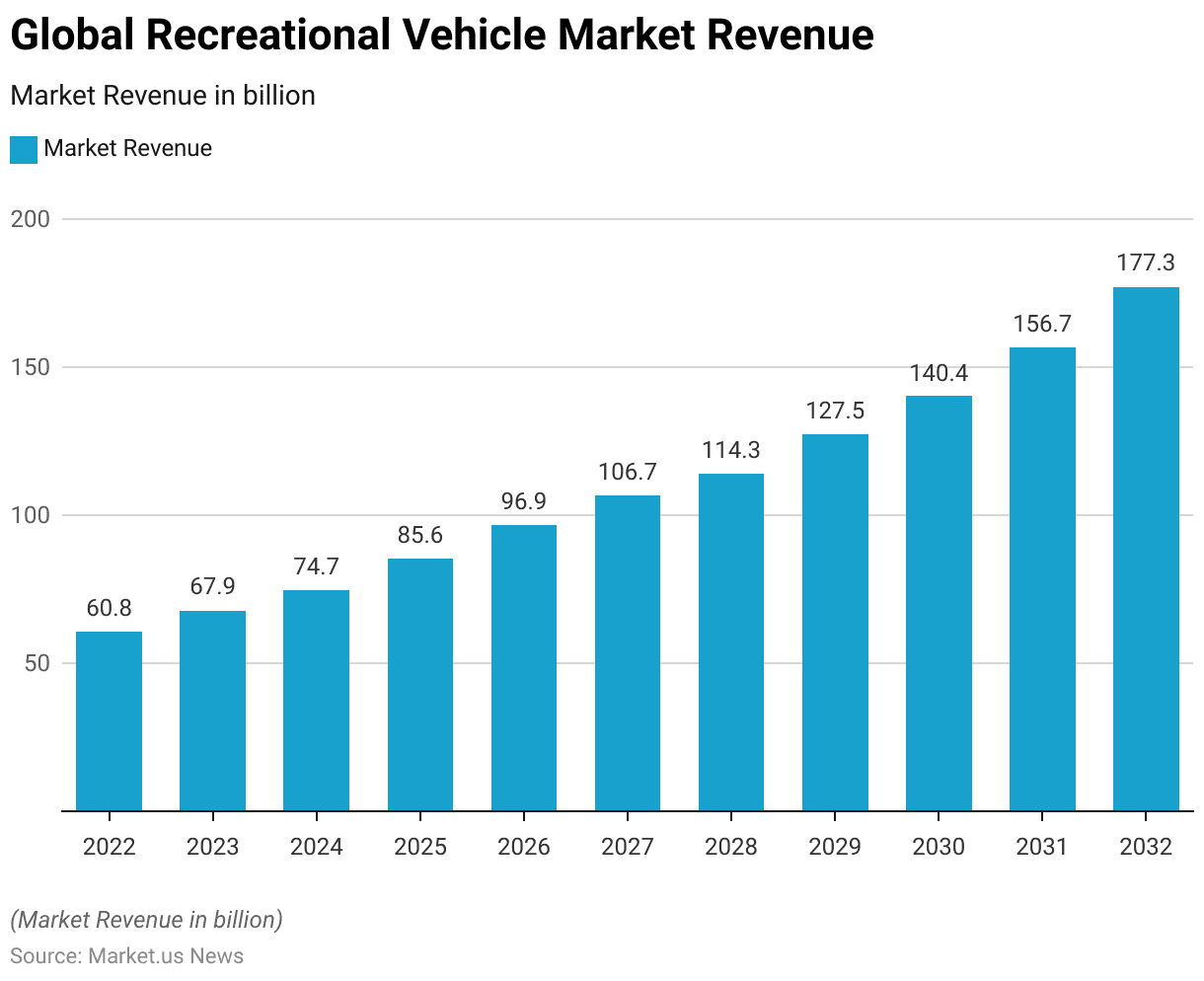
Global Recreational Vehicle Market Size – By Application Type Statistics
- The global recreational vehicle market, segmented by application type into personal and commercial uses, has shown a progressive increase in revenues from 2022 through 2032.
- In 2022, the total market revenue was recorded at $60.8 billion, with personal use contributing $38.3 billion and commercial use accounting for $22.5 billion. By 2023, the market expanded to $67.9 billion, with personal revenue at $42.8 billion and commercial revenue at $25.1 billion.
- The upward trend persisted, with total revenues reaching $74.7 billion in 2024, $85.6 billion in 2025, and $96.9 billion in 2026, where personal revenues were $47.1 billion, $53.9 billion, and $61.0 billion, respectively. Commercial revenues followed at $27.6 billion, $31.7 billion, and $35.9 billion, respectively.
- In 2027, the market size increased to $106.7 billion, with personal and commercial revenues at $67.2 billion and $39.5 billion, respectively. This growth continued, reaching $114.3 billion in 2028, with personal revenue climbing to $72.0 billion and commercial revenue to $42.3 billion.
- The market expanded significantly in the subsequent years, achieving $127.5 billion in 2029, $140.4 billion in 2030, and $156.7 billion in 2031, with respective personal revenues of $80.3 billion, $88.5 billion, and $98.7 billion, and commercial revenues increasing to $47.2 billion, $51.9 billion, and $58.0 billion.
- By 2032, the total market revenue was projected to reach $177.3 billion, with personal revenue contributing $111.7 billion and commercial revenue $65.6 billion. This data reflects a strong growth trend in both personal and commercial applications within the recreational vehicle market over the last ten years.
(Source: market.us)
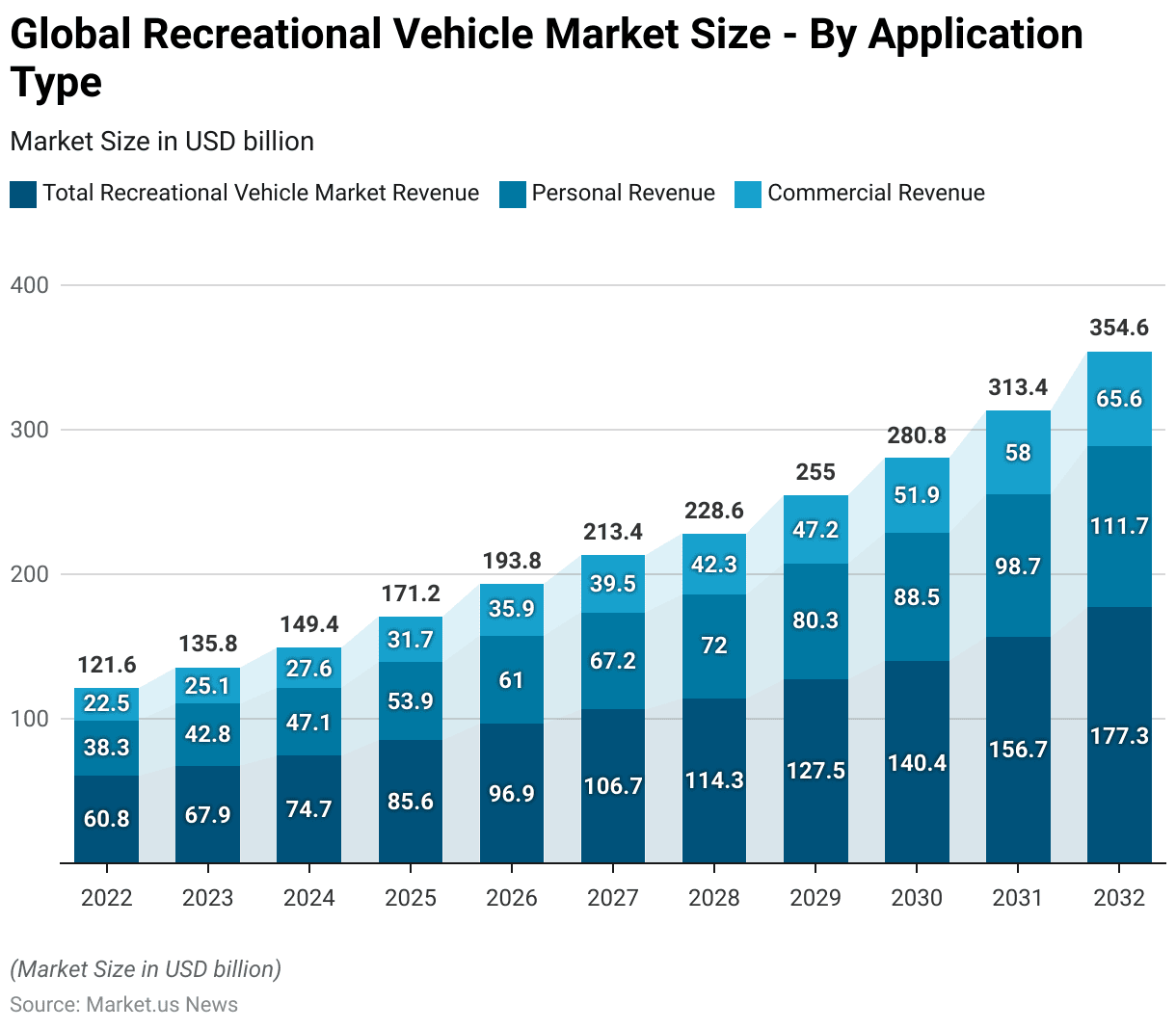
History of Recreational Vehicle
- The history of recreational vehicles (RVs) traces back to the early 20th century, aligning closely with the advent of motorized vehicles.
- The first notable RV, the Pierce-Arrow Touring Landau, was introduced in 1910 and featured amenities such as a fold-out bed and a built-in sink, establishing the foundation for modern RV designs.
- During the 1920s, the concept of travel trailers gained momentum, epitomized by Wally Byam’s Airstream prototypes, which evolved into the iconic “silver bullet” trailers.
- As RVs increased in popularity, they diversified into various forms, catering to both personal and commercial uses. This evolution was supported by a vibrant, enthusiastic community, starting with the “Tin Can Tourists” in 1919, a group that symbolized the burgeoning RV culture.
- In terms of market growth, the RV industry has shown significant expansion, especially in recent years. For instance, the RV industry’s economic impact was notably robust, with over $114 billion contributed to the U.S. economy in 2019, underlining its significance in supporting jobs and generating tax revenue.
- This sector has experienced a resurgence, particularly after the financial downturns, with increased sales and a broader demographic appeal, including younger generations like Millennials and Gen Z, who are drawn to the versatile and adventurous lifestyle that RVs offer.
- The data provided by the industry illustrates not only a rich history but a thriving present, with technological advancements and design innovations continuing to push the boundaries of what recreational vehicles can offer.
(Source: Smithsonian Magazine)
Price of Different Types of Recreational Vehicle Statistics
- The average prices of recreational vehicles (RVs) vary widely depending on the type and features. Pop-up campers, known for their affordability and simplicity, have an average price of approximately $16,900.
- Slightly more expensive, teardrop trailers, which are compact and efficient, typically cost around $23,900.
- Travel trailers offer more space and amenities, leading to an average price of $35,100.
- For those seeking more substantial and luxurious accommodations, fifth wheels are available at an average price of $70,000.
- Motorhomes, which provide the most comprehensive features for extended travel, come in three classes with significantly different price points: Class A motorhomes are the largest and most expensive, averaging $375,800; Class B motorhomes, which are smaller and more maneuverable, have an average price of $134,000; and Class C motorhomes, which strike a balance between size and cost, typically run about $148,000.
- These prices reflect the wide range of options available to consumers in the RV market, catering to various travel needs and budgets.
(Source: Camper Report 2021)
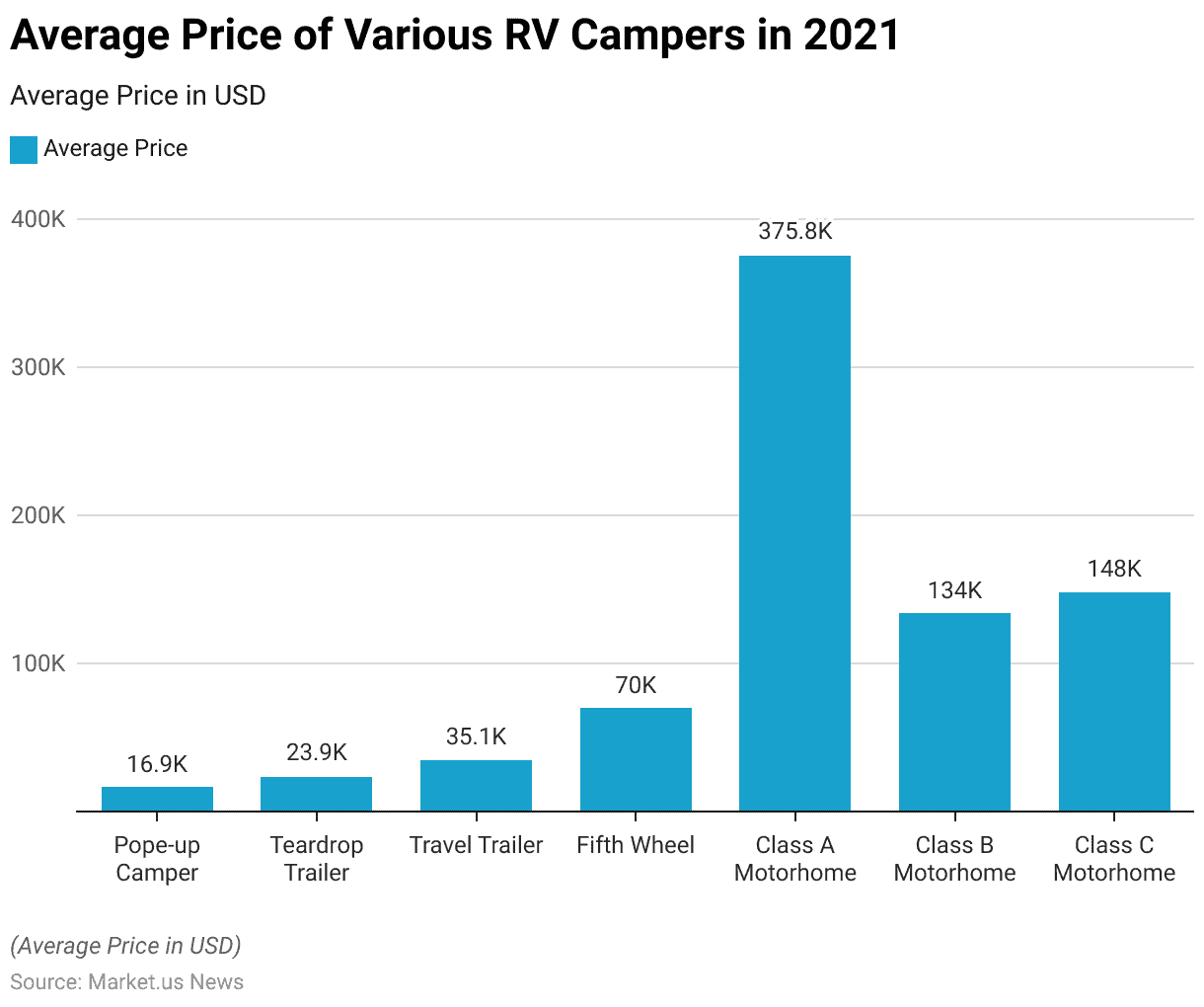
Demographics of Recreational Vehicle Owners
By Age
- According to a 2021 report from an RV industry association, approximately half of RV buyers are under 55 years old, with over 20% falling between 18 and 34 years old.
- Younger consumers, particularly Gen Z and millennials, show a stronger inclination to invest in recreational vehicles and boats in the coming year compared to Gen X and baby boomers.
- The market for boats and RVs is expected to expand to encompass Gen Z, millennials, Gen X, and baby boomers in the next few years.
- With millennials now the largest demographic group in the U.S., surpassing baby boomers in 2019, they are projected to dominate the market for these recreational vehicles until around 2036, when Gen Z is predicted to become the primary consumer segment.
(Source: RV Industry Association Report – 2021, Mckinsey)
By Gender
- In 2017, the landscape of U.S. RV dealer firms and RV parks showcased a diverse gender distribution among their operators.
- There were 2,046 RV dealer firms in total, with male ownership predominating at 1,353 firms.
- In contrast, women owned 211 of these firms. Additionally, 458 firms were equally owned by males and females.
- Regarding RV parks, the gender distribution was similarly varied; 1,458 parks were male-owned, 744 were female-owned, and both genders equally owned 1,519 parks.
- This data underscores a significant presence of gender diversity within the RV industry, reflecting a range of ownership across both parks and dealer firms.
(Source: Census Bureau’s Annual Business Survey)
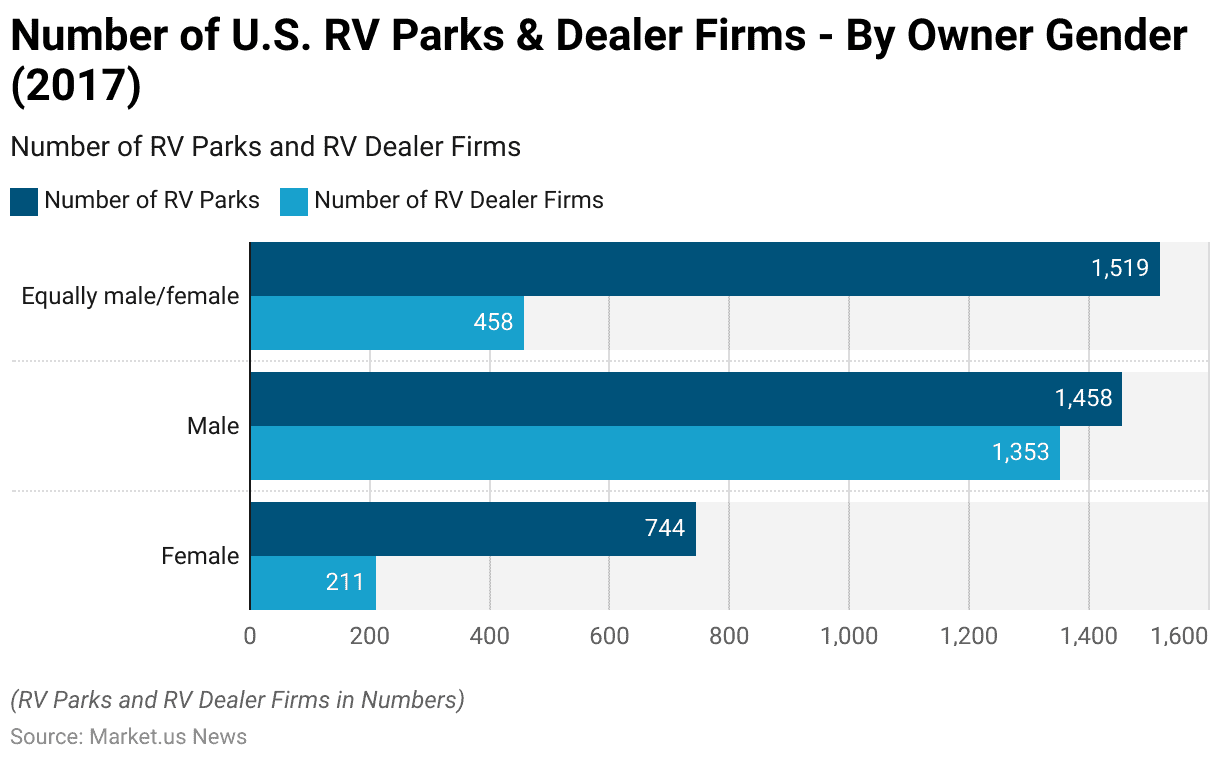
Global Camping Revenue
- The revenue generated by the global camping industry experienced a modest growth trajectory over the past few years.
- In 2018, it stood at $37.36 billion, marking the beginning of a gradual upward trend. This momentum continued into 2019, with revenues reaching $38.8 billion.
- Despite global economic fluctuations and the onset of the COVID-19 pandemic in 2020, the camping sector showcased resilience, recording a notable increase in revenue to $41.06 billion.
- However, the following years witnessed a slight decline, with revenues dipping to $40.08 billion in 2021 and further to $39.06 billion in 2022.
- Despite these fluctuations, the camping industry remains a significant player in the global leisure market, showcasing its enduring appeal to outdoor enthusiasts and travelers alike.
(Source: RV Industry Association)
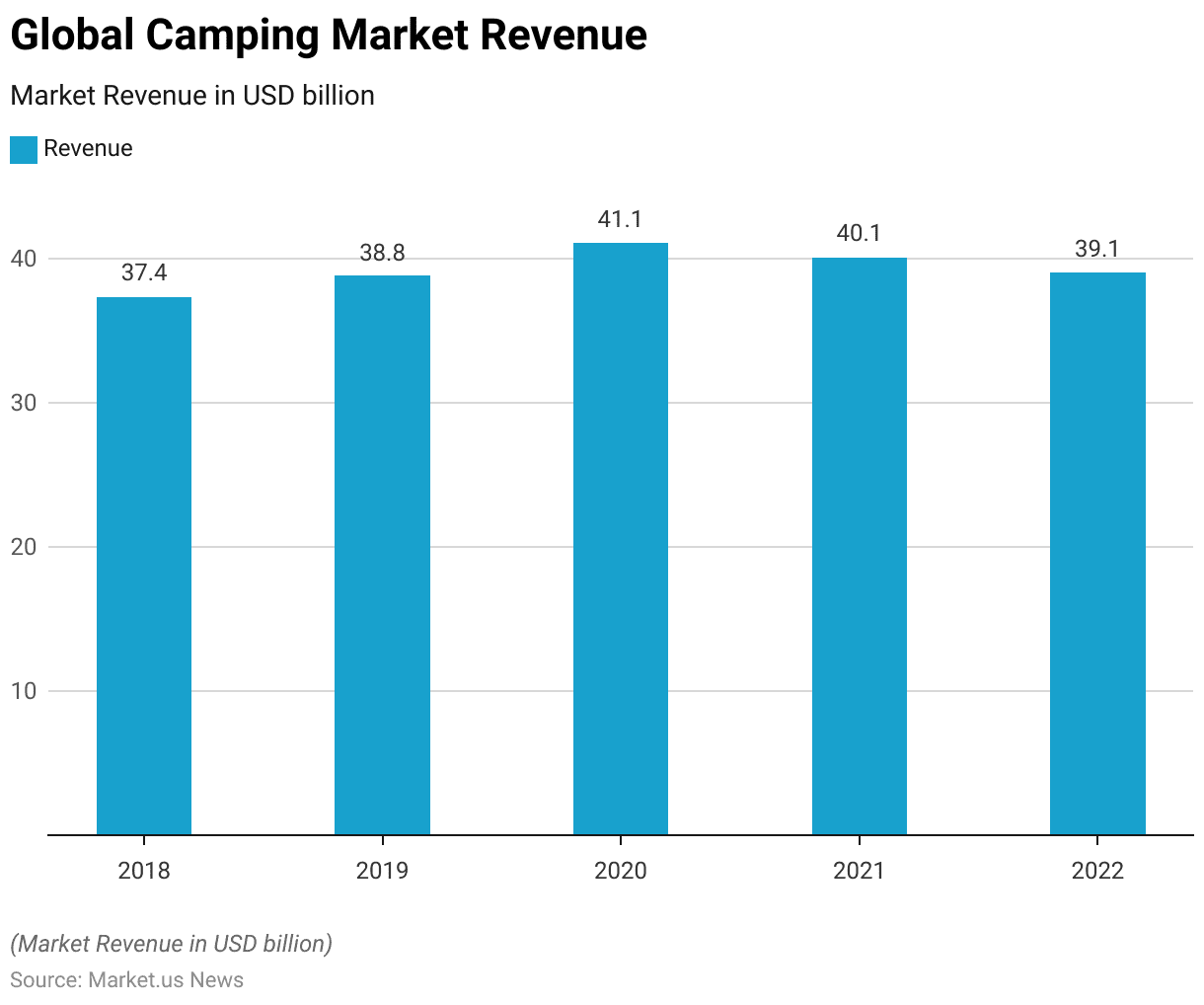
Revenue Generated by Recreational Vehicle Grounds and Campgrounds Statistics
- The industry revenue of recreational vehicle parks and campgrounds in New York has demonstrated fluctuating trends over the past decade.
- Starting at $86.82 million in 2014, the revenue steadily increased to $109.21 million by 2019, indicating consistent growth in the sector.
- However, in 2020, a notable decline occurred, with revenue plummeting to $61.34 million, likely due to the impact of the COVID-19 pandemic, which disrupted travel and tourism activities.
- Despite this setback, the industry showed resilience, rebounding to $73.2 million in 2021. Subsequently, in 2022, revenue surged to $92.44 million, marking a significant recovery.
- This positive momentum continued into 2023 and 2024, with revenue reaching $119.43 million and $121.43 million, respectively, indicating a robust resurgence and potential for sustained growth in the recreational vehicle parks and campgrounds sector in New York.
(Source: Statista)
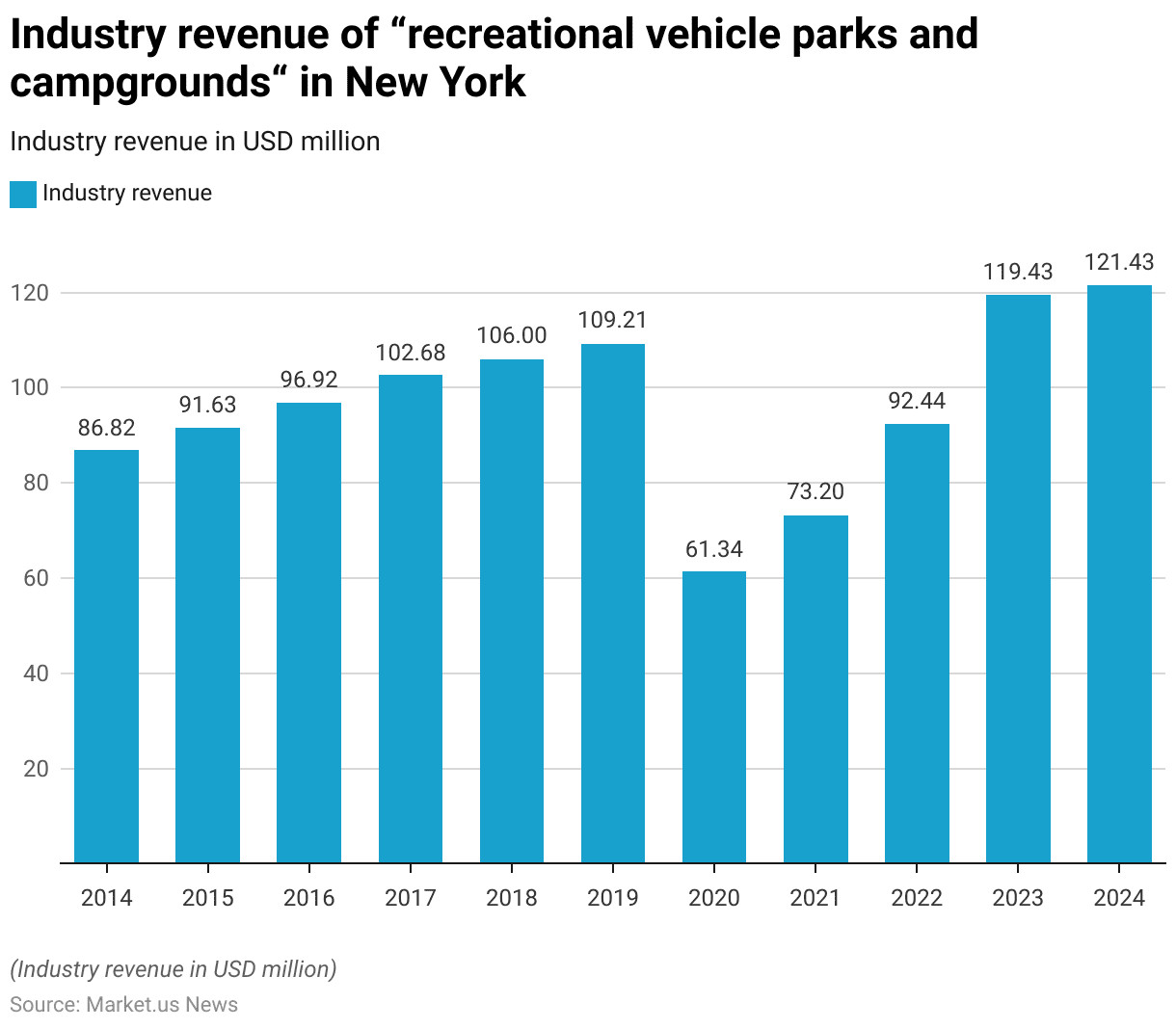
Recreational Vehicle Manufacturing Statistics
- In the United States, there are more than 100 companies that focus solely on making RVs.
- Together with other North American manufacturers, they pumped out about 482,389 RVs in 2018.
- Plus, there are roughly 300 businesses involved in making, distributing, and supplying parts, adding up to about 23,000 enterprises in the RV industry.
- All these companies create about 45,000 jobs and pay out $3 billion in wages. Each year, around 94,000 fifth-wheel travel trailers and 62,000 motorhomes hit the road.
- But it’s not all smooth sailing. In the first quarter of 2019, the industry took a hit, with shipments dropping by a significant 27% compared to the same time in 2018. Tough break, but the industry’s resilience will likely see it through.
(Sources: RVIA, WSJ)
Impact of the COVID-19 Pandemic on the RV Industry
- In 2020, RV shipments soared to over 600,000, a remarkable 19% increase from the previous record set in 2017.
- During the COVID-19 pandemic, 72% of RV owners expressed a greater inclination to embark on RV trips.
- January 2022 witnessed a 16% surge in total RV shipments compared to January 2021, totaling 53,290 units.
- Between July 2020 and June 2021, the DVLA in the UK registered 16,608 new motorhomes, marking an 8.25% increase from the prior record set in 2018/19.
- A notable 31% of respondents in a 2021 survey identified as first-time RV owners, indicating the industry’s rapid expansion.
- Moreover, 61% reported safely utilizing their RVs throughout the COVID-19 pandemic.
- However, by the first 11 months of 2022, shipments experienced a 15.6% decline from the corresponding period in 2021.
- March 2023 saw a drastic 50.8% decrease in RV shipments compared to March 2022.
(Sources: Forbes, Yahoo, RVTrader, Dreambigtravelfar, AboutCamp, Gitnux, BISHs)
Recent Trends and Popularity of Recreational Vehicle Statistics
- In the United States, conventional travel trailers constitute approximately 20% of all recreational vehicles (RVs).
- Sales data from 2018 indicates that over 289,940 travel trailers were purchased during that year. The Jayco Jay Flight emerged as the top-selling travel trailer, capturing a significant market share of 6.9%.
- Household ownership of Type A or fifth-wheel motorhomes stands at 14%.
- Among fifth-wheel motorhomes, the Keystone Montana was the best-selling model in 2018, commanding 8% of sales.
- Park Model RV ownership accounts for 12% of households.
- Annually, approximately 94,000 fifth-wheel motorhomes are shipped, establishing them as the predominant choice among families.
- Additionally, 62,000 motorhomes are shipped yearly.
- Class A motorhomes, renowned for their luxury and expense, represent the pinnacle of the RV market. Winnebago dominated this segment in 2018, capturing 14% of the market share.
- Despite a recent decline in sales for these high-end motorhomes, Winnebago has consistently maintained its position as the leading brand for three consecutive years.
(Sources: RV Hive, Wandering RV, Business Insider, RVLife, Camping World)
Recent Developments
New Product Launches and Innovations:
- Thor Industries: Launched electric RV concepts, including the eStream travel trailer with a high-voltage electric chassis to enhance range and fuel efficiency.
- Winnebago Industries: Introduced an all-electric, zero-emission vehicle with an 86-kWh battery, providing a 125-mile range.
- Leisure Travel Vans: Released next-generation Murphy Bed Lounge models for Wonder and Unity product lines, featuring a slide-out room and advanced air conditioning.
Acquisitions and Mergers:
- Trigano: Acquired a 70% stake in French leisure vehicle distributors CLC, SLC, and Loisiréo to strengthen its European distribution network.
- Forest River: Purchased 150 EV Star Cab and Chassis units from GreenPower Motor Company to support a new line of zero-emission products.
Strategic Partnerships and Collaborations:
- Winnebago Industries: Partnered with Paretta Autosport to promote inclusivity in the RV industry through their new flagship Class A Journey motorhome.
Market Trends and Growth:
- North American Market Dominance: The U.S. remains the largest market, with over 600,000 RV shipments in 2021, a 30% increase from 2020.
- Rental Market Expansion: Increased preference for RV rentals due to high maintenance costs and fuel prices, driving growth in the commercial segment.
Technological Advancements:
- Electric and Hybrid Vehicles: Significant focus on developing electric motorhomes and trailers to meet shifting consumer preferences towards eco-friendly options.
Economic Impact:
- US Economic Contribution: The RV industry contributes approximately USD 114 billion to the U.S. economy, supporting over 600,000 jobs.
Conclusion
Recreational Vehicle Statistics – In conclusion, the recreational vehicle (RV) market is experiencing significant growth driven by rising interest in outdoor activities, experiential travel, and the need for flexible vacation options.
The COVID-19 pandemic has further fueled demand for RVs as safer alternatives to traditional forms of travel.
Despite supply chain challenges, the market remains resilient, supported by technological advancements and eco-friendly features.
Looking ahead, favorable economic conditions and a focus on sustainability are expected to sustain this growth trajectory.
However, stakeholders must remain vigilant of regulatory changes and consumer preferences to capitalize on emerging opportunities.
Overall, the future outlook for the RV market is promising, with continued innovation and adaptation essential for long-term success.
FAQs
An RV, or recreational vehicle, is a motorized or towable vehicle equipped with living quarters for accommodation. It serves as a mobile home during travel and leisure activities.
RVs come in various types, including motorhomes (Class A, B, and C), travel trailers, fifth-wheel trailers, camper vans, and pop-up campers. Each type offers different features and amenities to suit varying preferences and travel styles.
RV travel offers flexibility, convenience, and the opportunity to explore diverse destinations while enjoying the comforts of home. It allows travelers to customize their itinerary, save on accommodation costs, and experience outdoor adventures with family and friends.
Maintenance costs for RVs can vary depending on factors like vehicle type, age, and usage. Regular maintenance, including inspections, servicing, and repairs, is essential to ensure the safety and longevity of the vehicle.
RV travel is generally safe when proper precautions are taken, such as regular maintenance, safe driving practices, and adherence to campground rules and safety guidelines. It’s essential to prioritize safety and be prepared for emergencies while on the road.
Sources.

Tajammul Pangarkar
Tajammul Pangarkar is a tech blogger that frequently contributes to numerous industry-specific magazines and forums. Tajammul longstanding experience in the fields of mobile technology and industry research is often reflected in his insightful body of work. His interest lies in understanding tech trends, dissecting mobile applications, and in raising a general awareness of technical know-how. When he’s not ruminating about various happenings in the tech world, he can be usually found indulging in his next favorite interest - table tennis.
Latest from Author
- Food and Nutrition Statistics 2024 By Health, Value, Ratio
- Healthy Snack Market Is Estimated to be Worth USD 142.6 Billion by 2032-end at a CAGR of 5.5%
- Ready Meals Market Size to Reach USD 297+ Billion by 2033 – Rise with Steller CAGR 7.3%
- Home Improvement Projects Favor Economic Conditions for Homeowners to Access Funds
- GABA (gamma-aminobutyric acid) Market Value to Hit USD 143.6 Million in 2033